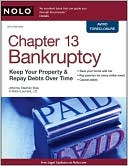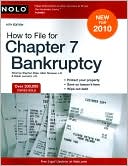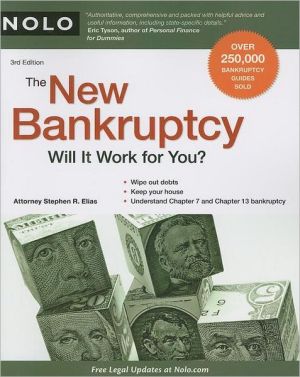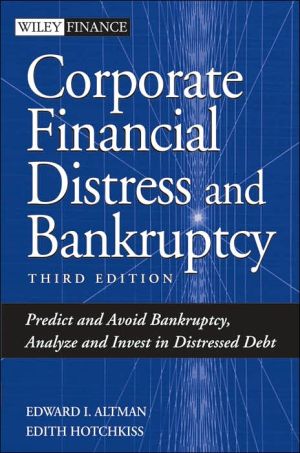Chapter 13 Bankruptcy: Keep Your Property and Repay Debts over Time
Search in google:
Reduce your debts, save your property -- and start over!Are you behind on your mortgage, taxes or other bills? Are creditors threatening foreclosure or repossession? This book will show you how to save your house, car and other assets with Chapter 13 Bankruptcy. It lets you cancel your debts and pay off the rest with an affordable repayment plan.The 10th edition is completely rewritten to reflect the recent (and massive) changes to federal bankruptcy law, as well as the latest bankruptcy exemption laws of your state. It also includes the most current legal documents and instructions on filling them out. Forbes Magazine An excellent book that can guide you through the [Chapter 13] process.
Part I 1. How Chapter 13 Works An Overview of Chapter 13 Bankruptcy Which Debts Are Discharged in Chapter 13 Bankruptcy Is Chapter 13 Right for You? Alternatives to Bankruptcy 2. The Automatic Stay How Long the Stay Lasts How the Stay Affects Common Collection Actions How the Stay Affects Actions Against Codebtors When the Stay Doesn't Apply Evictions 3. Are You Eligible to Use Chapter 13? Prior Bankruptcy Discharges May Postpone Your Chapter 13 Discharge Business Entities Can't File for Chapter 13 Bankruptcy Your Debts Must Not Be Too High You Must Be Current on Your Income Tax Filings You Must Keep Making Your Child Support and Alimony Payments You Must File Annual Income and Expense Reports Your Proposed Repayment Plan Must Pay All Required Debts Your Proposed Payments Must Equal the Value of Your Nonexempt Assets You Must Participate in an Approved Personal Financial Management Course 4. Do You Have to Use Chapter 13? Can You Pass the Means Test? Forced Conversion to Chapter 13 5. Can You Propose a Plan the Judge Will Approve? If Your Current Monthly Income Is Less Than Your State's Median Income If Your Current Monthly Income Is More Than Your State's Median Income Understanding Property Exemptions 6. Making the Decision Part II 7. Complete Your Bankruptcy Forms Get Some Information From the Court Required Forms For Married Filers Form 1 -- Voluntary Petition Form 6 -- Schedules Form 7 -- Statement of Financial Affairs Form 21 -- Statement of Social Security Number Form B22C -- Statement of Current Monthly Income and Means-Test Calculation Form B201 -- Notice to Individual Consumer Debtor Under § 342(b) of the Bankruptcy Code Mailing Matrix Income Deduction Order 8. Drafting Your Plan Chapter 13 Plan Formats What Your Plan Must Pay -- And to Whom Repayment of Unsecured Debts: Allowed Claims A Model Plan Format Sample Plan 9. Filing Your Bankruptcy Papers Gather the Necessary Documents Get Filing Information From the Court How to File Your Papers After You File 10. Handling Routine Matters After You File The Automatic Stay Dealing With the Trustee Make Your First Payment Keep Your Business Going The Meeting of Creditors Modifying Your Plan Before the Confirmation Hearing The Confirmation Hearing Modifying Your Plan After the Confirmation Hearing Amending Your Bankruptcy Forms Filing a Change of Address Filing Tax Returns Filing Annual Income and Expense Statements Personal Financial Management Counseling Part III 11. Handling Legal Issues Filing Motions Dealing With Creditors' Motions If an Unsecured Creditor Objects to Your Plan Handling Creditors' Claims Asking the Court to Eliminate Liens 12. Carrying Out Your Plan Making Plan Payments Selling Property Modifying Your Plan When Problems Come Up Attempts to Revoke Your Confirmation When You Complete Your Plan 13. If You Cannot Complete Your Plan Dismiss Your Case Convert Your Case to Chapter 7 Bankruptcy Seek a Hardship Discharge 14. Life After Bankruptcy Rebuilding Your Credit Attempts to Collect Clearly Discharged Debts Postbankruptcy Discrimination Attempts to Revoke Your Discharge 15. Help Beyond the Book Debt Relief Agencies Bankruptcy Petition Preparers Bankruptcy Lawyers Legal Research Glossary Appendixes 1. State and Federal Exemption Charts 2. Tear-Out Forms 3. Charts Index







